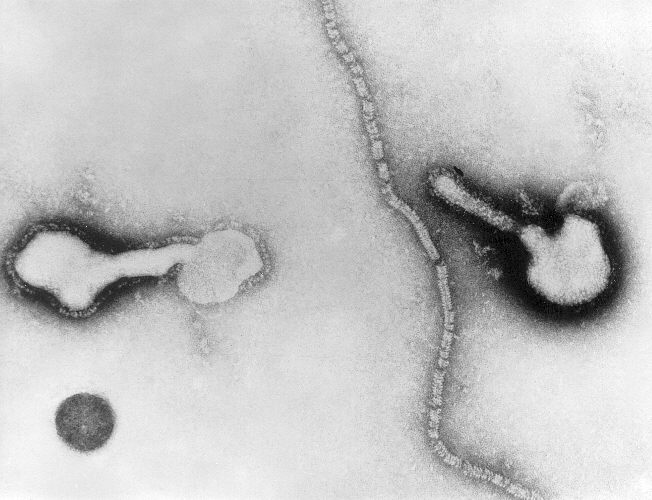Human parainfluenza viruses: Difference between revisions
Jump to navigation
Jump to search
Shanshan Cen (talk | contribs) No edit summary |
|||
| (12 intermediate revisions by 2 users not shown) | |||
| Line 2: | Line 2: | ||
[[Image:Parainfluenza virus TEM PHIL 271 lores.jpg|right|thumb|200px|right|Transmission electron micrograph of parainfluenza virus. Two intact particles and free filamentous nucleocapsid]] | [[Image:Parainfluenza virus TEM PHIL 271 lores.jpg|right|thumb|200px|right|Transmission electron micrograph of parainfluenza virus. Two intact particles and free filamentous nucleocapsid]] | ||
{{Human parainfluenza virus}} | {{Human parainfluenza virus}} | ||
'''For patient information click [[Human parainfluenza viruses (patient information)|here]].''' | |||
{{CMG}} | {{CMG}} | ||
== | ==[[Human parainfluenza viruses overview|Overview]]== | ||
Human parainfluenza viruses | |||
==[[Human parainfluenza viruses historical perspective|Historical Perspective]]== | |||
==[[Human parainfluenza viruses classification|Classification]]== | |||
==[[Human parainfluenza viruses pathophysiology|Pathophysiology]]== | |||
==[[Human parainfluenza viruses causes|Causes]]== | |||
== | ==[[Human parainfluenza viruses differential diagnosis|Differentiating Human parainfluenza viruses from other Disorders]]== | ||
==[[Human parainfluenza viruses epidemiology and demographics|Epidemiology and Demographics]]== | |||
==[[Human parainfluenza viruses risk factors|Risk Factors]]== | |||
==[[Human parainfluenza viruses natural history, complications and prognosis|Natural History, Complications and Prognosis]]== | |||
== | ==Diagnosis== | ||
[[Human parainfluenza viruses history and symptoms|History and Symptoms]] | [[Human parainfluenza viruses physical examination|Physical Examination]] | [[Human parainfluenza viruses laboratory findings|Laboratory Findings]] | [[Human parainfluenza viruses chest x ray|Chest X Ray]] | [[Human parainfluenza viruses other imaging findings|Other Imaging Findings]] | [[Human parainfluenza viruses other diagnostic studies|Other Diagnostic Studies]] | |||
==Treatment== | |||
[[Human parainfluenza viruses medical therapy|Medical Therapy]] | [[Human parainfluenza viruses prevention|Prevention]] | [[Human parainfluenza viruses cost-effectiveness of therapy|Cost-Effectiveness of Therapy]] | [[Human parainfluenza viruses future or investigational therapies|Future or Investigational Therapies]] | |||
==Case Studies== | |||
[[Human parainfluenza viruses case study one|Case #1]] | |||
[[Category:Pulmonology]] | [[Category:Pulmonology]] | ||
[[Category:Viruses]] | [[Category:Viruses]] | ||
{{jb1}} | {{jb1}} | ||
{{WH}} | {{WH}} | ||
{{WS}} | {{WS}} | ||
Latest revision as of 18:57, 10 August 2015

|
Human parainfluenza viruses Microchapters |
|
Differentiating Human parainfluenza viruses from other Diseases |
|---|
|
Diagnosis |
|
Treatment |
|
Case Studies |
|
Human parainfluenza viruses On the Web |
|
American Roentgen Ray Society Images of Human parainfluenza viruses |
|
Directions to Hospitals Treating Human parainfluenza viruses |
|
Risk calculators and risk factors for Human parainfluenza viruses |
For patient information click here.
Editor-In-Chief: C. Michael Gibson, M.S., M.D. [1]
Overview
Historical Perspective
Classification
Pathophysiology
Causes
Differentiating Human parainfluenza viruses from other Disorders
Epidemiology and Demographics
Risk Factors
Natural History, Complications and Prognosis
Diagnosis
History and Symptoms | Physical Examination | Laboratory Findings | Chest X Ray | Other Imaging Findings | Other Diagnostic Studies
Treatment
Medical Therapy | Prevention | Cost-Effectiveness of Therapy | Future or Investigational Therapies
Case Studies